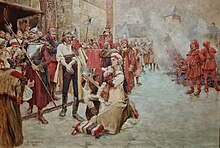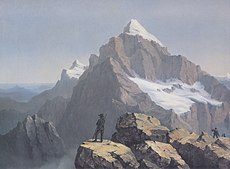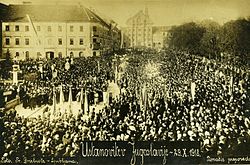History of Slovenia
Numerous archeological remains dating from the Hallstatt period have been found in Slovenia, with important settlements in Most na Soči, Vače, and Šentvid pri Stični.[2] In the Iron Age, present-day Slovenia was inhabited by Illyrian and Celtic tribes until the 1st century BC, when the Romans conquered the region establishing the provinces of Pannonia and Noricum.During the Migration Period, the region suffered invasions of many barbarian armies, due to its strategic position as the main passage from the Pannonian Plain to the Italian Peninsula.Carantania retained its internal independence until 818 when the local princes, following the anti-Frankish rebellion of Ljudevit Posavski, were deposed and gradually replaced by a Germanic (primarily Bavarian) ascendancy.Under Emperor Arnulf of Carinthia, Carantania, now ruled by a mixed Bavarian-Slav nobility, briefly emerged as a regional power, but was destroyed by the Hungarian invasions in the late 9th century.Carantania-Carinthia was established again as an autonomous administrative unit in 976, when Emperor Otto I, "the Great", after deposing the Duke of Bavaria, Henry II, "the Quarreller", split the lands held by him and made Carinthia the sixth duchy of the Holy Roman Empire, but old Carantania never developed into a unified realm.In the late 10th and beginning of the 11th century, primarily because of the Hungarian threat, the south-eastern border region of the German Empire was organized into so called "marks", that became the core of the development of the historical Slovenian lands, the Carniola, the Styria and the western Goriška/Gorizia.Most Slovenes lived in the administrative region known as Inner Austria, forming the majority of the population of the Duchy of Carniola and the County of Gorizia and Gradisca, as well as of Lower Styria and southern Carinthia.During the Counter-Reformation in the late 16th and 17th centuries, led by the bishop of Ljubljana Thomas Chrön and Seckau Martin Brenner, almost all Protestants were expelled from the Slovene Lands (with the exception of Prekmurje).A small number of Slovene activist, mostly from Styria and Carinthia, embraced the Illyrian movement that started in neighboring Croatia and aimed at uniting all South Slavic peoples.Between 1848 and 1918, numerous institutions (including theatres and publishing houses, as well as political, financial and cultural organisations) were founded in the so-called Slovene National Awakening.In the late 1860s and early 1870s, a series of mass rallies called tabori, modeled on the Irish monster meetings, were organized in support of the United Slovenia program.[11] Since the 1880s, a fierce culture war between Catholic traditionalists and integralists on one side, and liberals, progressivists and anticlericals dominated Slovene political and public life, especially in Carniola.At the turn of the 20th century, national struggles in ethnically mixed areas (especially in Carinthia, Trieste and in Lower Styrian towns) dominated the political and social lives of the citizenry.In the last two decades before World War One, Slovene arts and literature experienced one of its most flourishing periods, with numerous talented modernist authors, painters and architects.[13] At the turn of the 20th century, hundreds of thousands of Slovenes emigrated to other countries, mostly to the United States, but also to South America, Germany,[14] Egypt[15] and to larger cities in the Austro-Hungarian Empire, especially Zagreb and Vienna.The preservation of the reformed state was longest defended by the former head of the Slovenian People's Party and the last Provincial Commander-in-Chief of Carniola, Ivan Šusteršič, who had few supporters and influence.In October 1920, the majority of the population of southern Carinthia voted to remain in Austria, and only a small portion of the province (around Dravograd and Guštanj) was awarded to the Kingdom of Serbs, Croats and Slovenes.[24] Clashes between the Italian authorities and Fascist squads on one side, and the local Slovene population on the other, started as early as 1920, culminating with the burning of the Narodni dom, the Slovenian National Hall of Trieste.In Volkmerjev prehod in Maribor, on April 29, 1941, two anti-German-style young men under the leadership of Bojan Ilich burned two personal cars of the German Civil Administration.The VOS departments under the command of the Communist Party and the Soviet model, after the end of the war, mostly performed post-war extrajudicial killings against civilian and military personnel.The case of bishop of Ljubljana Anton Vovk, who was doused with gasoline and set on fire by Communist activists during a pastoral visit to Novo Mesto in January 1952, echoed in the western press.Among the most important critical public intellectuals in this period were the sociologist Jože Pučnik, the poet Edvard Kocbek, and the literary historian Dušan Pirjevec.A new economic policy, known as workers self-management started to be implemented under the advice and supervision of the main theorist of the Yugoslav Communist Party, the Slovene Edvard Kardelj.In 1987, a group of liberal intellectuals published a manifesto in the alternative Nova revija journal; in their so-called Contributions for the Slovenian National Program, they called for democratization and a greater independence for Slovenia.After the concept of a loose confederation failed to gain support by the republics of Yugoslavia, Kučan favoured a controlled process of non-violent disassociation that would enable the collaboration of the former Yugoslav nations on a new, different basis.The Ten-Day War lasted till 7 July 1991,[42] when the Brijuni Agreement was made, with the European Community as a mediator, and the Yugoslav National Army started its withdrawal from Slovenia.[43] Kučan represented Slovenia at the peace conference on former Yugoslavia in the Hague and Brussels which concluded that the former Yugoslav nations were free to determine their future as independent states.The most important achievement of the Coalition, however, was the declaration of independence of Slovenia on 25 June 1991, followed by a Ten-Day War in which the Slovenians rejected Yugoslav military interference.Drnovšek's governments reoriented Slovenia's trade away from Yugoslavia towards the West and contrary to some other former Communist countries in Eastern Europe, the economic and social transformation followed a gradualist approach.

















NoricumPannoniaSlavic settlement of the Eastern AlpsSamo's RealmCarantaniaCarneolaHoly Roman EmpireMarch of CarniolaHungarian MarchWindic MarchDuchy of CarniolaVenetian RepublicIllyrian ProvincesKingdom of IllyriaInner AustriaVenezia GiuliaDrava BanovinaWorld War II in the Slovene LandsSocialist Republic of SloveniaTen-Day WarRepublic of SloveniaSlovenian territoryEarly Bronze AgeIllyrianAlbaniaTriesteRoman EmpireMigration Periodlate AntiquityEarly Middle AgesPannonian plainAlpine SlavsSloveniansHabsburgKingdom of Serbs, Croats, and SlovenesKingdom of YugoslaviaLjubljanafederal YugoslaviaYugoslaviaEuropean UnionPrehistoric Europelast glacial periodNeanderthalsŠebreljeCerknoDivje BabeDivje Babe flutewheel and axleLjubljana MarshBronze AgeIron AgeUrnfield cultureHallstatt periodMost na SočiŠentvid pri StičniNovo MestoLower CarniolasitulasLjubljana Marshes WheelHallstatt cultureVače SitulaCelticRomansRoman ItaliaCeleiaPoetovioNauportusNeviodunumHaliaetumAtransStridonItalian PeninsulaOstrogothic KingdomOstrogothsByzantine EmpireLombardsSlovenesEast AlpineCarniolaKaravankeCarinthiaStyriaEast TyrolSloveneCarolingian EmpireCarantaniansconverted to ChristianityFrankishLjudevit PosavskiBavarianArnulf of CarinthiaHungarian"marks"Dukes of SpanheimCounts of GoriziaCounts of CeljeHouse of HabsburgFreising ManuscriptsHabsburg monarchyCounty of Gorizia and GradiscaLower StyriaImperial Free CityHabsburgsGreat Turkish WarProtestant ReformationProtestantPrimož TrubarJurij DalmatinCounter-ReformationThomas ChrönPrekmurjeold Slovene orthographyBohoričOttoman–Habsburg warsVipavski KrižKostanjevica na KrkiOttoman ArmyOttoman EmpireCarniolanBattle of SisakMatija GubecCroatian–Slovene Peasant RevoltWar of GradiscaGoriškaCarinthian Peasant RevoltSlovene Peasant Revolt of 1515
